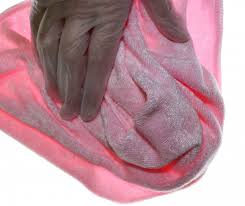

Textile finishing with both an antiviral and an antibacterial function has been developed for the first time by scientists from the Hohenstein Institute in Bönnigheim, as part of an AiF research project. The research project bring to light that antiviral cleaning cloths provide an efficient hygienic effect and can help to reduce the germ transfer rate.
Most infection-induced respiratory problems are caused by viruses. For example, the respiratory syncytial virus, a pathogen belonging to the family of paramyxoviruses, can cause infections of the upper respiratory tract in the form of colds, coughs, acute bronchitis or even pneumonia, particularly in small children.
To avoid droplet and smear infections as far as possible, hygienic hands, textiles and surfaces are of paramount importance.
The essential factor in avoiding or limiting the spread of disease in childcare facilities is regular and thorough handwashing, by children and their carers.
However, textiles can also play a part in spreading pathogens. Viruses do not have their own metabolism and can therefore only survive for a limited time outside a host, and unlike bacteria, do not multiply there. However, as studies have impressively documented, textiles that are in regular contact with hands have been proven to contribute to the spread of viruses (Sauver et al., 1998). In a scientific examination, clothes as well as domestic and hospital textiles in the form of bed linen, towels, kitchen towels and so on are, alongside hands, an important potential transmission route for viruses.
Surfaces of all kinds, which can also be contaminated by viruses and bacteria via the hands or air, are the third key transmission route for viruses. One important element in preventing infection is therefore the cleaning of surfaces. The Hohenstein scientists are investigating these factors in their current research project.
The test design included cleaning cloths in which, for the first time, antiviral and antibacterial effectiveness were combined with each other in one functional textile finishing. Over the long term, they are interested in finding out whether the risk of infection, that is to say the spread of germs from person to person, can be reduced by using biofunctional textiles in the future, says Prof. Höfer, head of the hygiene, environment and medicine department.
To achieve this goal, various organic and inorganic colloidal or nanoparticle copper compounds and copper complexes were first applied in a sol-gel process. The effectiveness of the textile microfibre substrate was optimised using various application techniques such as foulard or spray methods. The inactivation of the test viruses was significant, was retained over 15 washing cycles and was at the same time abrasion-resistant.
A second alternative antiviral finish of microfibre cloths was achieved by finishing with copper pigments in a high-temperature exhaust process. In a similar way to dying with dispersion dyes, the dispersed copper pigments were incorporated in the fibres in a slightly acid environment. In a second step, fixing was carried out using a polymer binding agent in a cold padding process to protect the copper particles against mechanical abrasion. These copper finishes also produced good evenness, but there was a slight green tone compared to the originally lighter fabric colour.
All samples passed the laboratory tests on skin-friendliness.
The effectiveness tests under realistic conditions were carried out on different surfaces, such as glass, stainless steel or wood, which were contaminated with viruses and wiped with the finished cleaning cloths. The bacterial virus MS2, a non-pathogenic surrogate virus, which due to its structure and environmental stability is comparable to clinically relevant viruses such as novovirus, poliovirus, hepatitis A or enteroviruses, was used as the test virus. The finished microfibre cloths absorbed 91% of the applied viruses. At the same time, the virus concentration in the cloth was reduced by approximately 90%. Effectiveness tests against bacteria and mould were also carried out in accordance with standards (DIN EN ISO 20743 and EN 14119). With this test set-up, the finishes were optimised in a targeted manner.
This textile technology can be used for products in nurseries, child day care centres, hospitals and in protective clothing for the fire brigade, emergency services and military to interrupt chains of infection.
Kathmandu has launched Seeker range, an innovative and sustainable activewear collection that merges eco-friendly advancements with functional design.
The Global Organic Textile Standard (GOTS), managed by the non-profit organization Global Standard, has joined the Make the Label Count…
Packaging company Pact Group has partnered with textile recycling technology firm BlockTexx to develop a system for recycling discarded clothing…
Loftex USA is strengthening sustainability with the launch of eco-friendly towel sets, blending innovative performance features with luxurious designs.
Toray Industries, Inc. announced that starting this April, it will implement the mass balance approach in manufacturing its TORAYLON™ acrylic…
Cxffeeblack has joined forces with COMOCO Cotton, a sustainable textile company, to create a special coffee-dyed T-shirt made from unbleached…